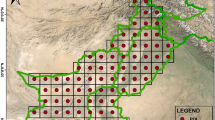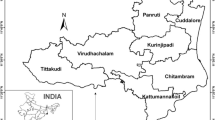Abstract
Understanding the spatiotemporal relationships between land use/cover changes (LUCC) and groundwater resources is necessary for effective and efficient land use management. In this paper, geographically weighted regression (GWR) and ordinary least squares (OLS) models have been expanded to analyze varying spatial relationships between groundwater quantity changes and LUCC for three periods: 1987–2000, 2000–2010, and 1987–2010 in the Khanmirza Plain of southwestern Iran. For this purpose, TM images were used to generate LUCC (rainfed, irrigated, meadow, and bare lands). Groundwater quantity variables, including groundwater level changes (GLC) and groundwater withdrawal differences (GWD), were gathered from piezometric and agricultural wells data. The analysis of spatial autocorrelation (Moran’s I and local indicators of spatial association ) demonstrated that GWR has a better ability to model spatially varying data with very minimal clustering of residuals. The results R 2 and corrected Akaike’s Information Criterion parameters revealed that the GWR has the lowest similarity in space and time in neighboring situations and it has the high ability to explain more variance in the LUCC as a function of the groundwater quantity changes. All results of the distribution of local R 2 values from GWR confirm our assertion that there is a spatiotemporal relationship between types of land use and each of groundwater quantity variables within the region. According to the t test results from GWR, there are significant differences between the GLC and GWD and the land use types in different places of region in each of the three time series. The GWR results can help decision-makers to make appropriate decisions for future planning.








Similar content being viewed by others
References
Brown, S., Versace, V. L., Laurenson, L., Ierodiaconou, D., Fawcett, J., & Salzman, S. (2012). Assessment of spatiotemporal varying relationships between rainfall, land cover and surface water area using geographically weighted regression. Environmental Modeling and Assessment, 17(3), 241–254.
Brunsdon, C., Fotheringham, A. S., & Charlton, M. E. (1996). Geographically weighted regression: a method for exploring spatial nonstationarity. Geographical Analysis, 28(4), 281–298.
Chen, C. H., Wang, C. H., Hsu, Y. J., Yu, S. B., & Kuo, L. C. (2010). Correlation between groundwater level and altitude variations in land subsidence area of the Choshuichi Alluvial Fan, Taiwan. Engineering Geology, 115(1), 122–131.
Fianko, J. R., Osae, S., Adomako, D., & Achel, D. J. (2009). Relationship between land use and groundwater quality in six districts in the eastern region of Ghana. Environmental Monitoring and Assessment, 153, 139–146.
Fotheringham, A. S., & Brunsdon, C. (1999). Local forms of spatial analysis. Geographical Analysis, 31(4), 340–358.
Fotheringham, A. S., Charlton, M. E., & Brunsdon, C. (2001). Spatial variations in school performance: a local analysis using geographically weighted regression. Geographical and Environmental Modelling, 5(1), 43–66.
Fotheringham, A. S., Brunsdon, C., & Charlton, M. (2002). Geographically weighted regression: the analysis of spatially varying relationships (Vol. 13): Wiley Chichester.
Gao, J., & Li, S. (2011). Detecting spatially non-stationary and scale-dependent relationships between urban landscape fragmentation and related factors using Geographically Weighted Regression. Applied Geography, 31(1), 292–302.
Gardner, K. K., & Vogel, R. M. (2005). Predicting ground water nitrate concentration from land use. Ground Water, 43(3), 343–352.
Geri, F., Amici, V., & Rocchini, D. (2010). Human activity impact on the heterogeneity of a Mediterranean landscape. Applied Geography, 30(3), 370–379.
Harrington, L., Harrington, J., Jr., & Kettle, N. (2007). Groundwater depletion and agricultural land use change in the high plains: a case study from Wichita County, Kansas. The Professional Geographer, 59(2), 221–235.
Kamarianakis, Y., Feidas, H., Kokolatos, G., Chrysoulakis, N., & Karatzias, V. (2008). Evaluating remotely sensed rainfall estimates using nonlinear mixed models and geographically weighted regression. Environmental Modelling & Software, 23(12), 1438–1447.
Keser, S., Duzgun, S., & Aksoy, A (2011). Application of spatial and non-spatial data analysis in determination of the factors that impact municipal solid waste generation rates in Turkey. Waste management.
Kupfer, J. A., & Farris, C. A. (2007). Incorporating spatial non-stationarity of regression coefficients into predictive vegetation models. Landscape Ecology, 22(6), 837–852.
Lerner, D. N., & Harris, B. (2009). The relationship between land use and groundwater resources and quality. Land Use Policy, 26, S265–S273.
Li, S., Zhao, Z., Miaomiao, X., & Wang, Y. (2010). Investigating spatial non-stationary and scale-dependent relationships between urban surface temperature and environmental factors using geographically weighted regression. Environmental Modelling & Software, 25(12), 1789–1800.
Mennis, J. (2006). Mapping the results of geographically weighted regression. The Cartographic Journal, 43(2), 171–179.
Pineda Jaimes, N. B., Bosque Sendra, J., Gómez Delgado, M., & Franco Plata, R. (2010). Exploring the driving forces behind deforestation in the state of Mexico (Mexico) using geographically weighted regression. Applied Geography, 30(4), 576–591.
Pratt, B., & Chang, H (2012). Effects of land cover, topography, and built structure on seasonal water quality at multiple spatial scales. Journal of Hazardous Materials.
Propastin, P. (2012). Modifying geographically weighted regression for estimating aboveground biomass in tropical rainforests by multispectral remote sensing data. International Journal of Applied Earth Observation and Geoinformation, 18, 82–90.
Ray, D. K., Pijanowski, B. C., Kendall, A. D., & Hyndman, D. W. (2012). Coupling land use and groundwater models to map land use legacies: assessment of model uncertainties relevant to land use planning. Applied Geography, 34, 356–370.
Regional water company of Chaharmahal-Bakhtyari Province. (2009). Water resources studies of Khanmirza plain.
Robinson, D., Lloyd, C., & McKinley, J. (2011). Increasing the accuracy of nitrogen dioxide (NO2) pollution mapping using geographically weighted regression (GWR) and geostatistics. International Journal of Applied Earth Observation and Geoinformation.
Sá, A. C. L., Pereira, J. M. C., Charlton, M. E., Mota, B., Barbosa, P. M., & Stewart Fotheringham, A. (2011). The pyrogeography of sub-Saharan Africa: a study of the spatial non-stationarity of fire–environment relationships using GWR. Journal of Geographical Systems, 13(3), 227–248.
Shi, M., (2008). Literature review: change and feedbacks of land-use and land-cover under global change: The University of Texas at Austin.
Shi, H., Zhang, L., & Liu, J. (2006). A new spatial-attribute weighting function for geographically weighted regression. Canadian Journal of Forest Research, 36(4), 996–1005.
Statistical Yearbook of Chaharmahal-Bakhtyari Province. (2009). Statistical Center of Iran.
Su, S., Xiao, R., & Zhang, Y. (2012). Multi-scale analysis of spatially varying relationships between agricultural landscape patterns and urbanization using geographically weighted regression. Applied Geography, 32(2), 360–375.
Tong, S. T. Y., & Chen, W. (2002). Modeling the relationship between land use and surface water quality. Environmental Management, 66(4), 377–393.
Tu, J. (2011). Spatially varying relationships between land use and water quality across an urbanization gradient explored by geographically weighted regression. Applied Geography, 31(1), 376–392.
Tu, J. (2013). Spatial variations in the relationships between land use and water quality across an urbanization gradient in the watersheds of northern Georgia, USA. Environmental Management, 51, 1–17.
Tu, J., & Xia, Z. G. (2008). Examining spatially varying relationships between land use and water quality using geographically weighted regression I: model design and evaluation. Science of the Total Environment, 407(1), 358–378.
Wang, Q., Ni, J., & Tenhunen, J. (2005). Application of a geographically-weighted regression analysis to estimate net primary production of Chinese forest ecosystems. Global Ecology and Biogeography, 14(4), 379–393.
Weatherhead, E., & Howden, N. (2009). The relationship between land use and surface water resources in the UK. Land Use Policy, 26, S243–S250.
Wheeler, D., & Tiefelsdorf, M. (2005). Multicollinearity and correlation among local regression coefficients in geographically weighted regression. Journal of Geographical Systems, 7(2), 161–187.
Xu, Y., Mo, X., Cai, Y., & Li, X. (2005). Analysis on groundwater table drawdown by land use and the quest for sustainable water use in the Hebei Plain in China. Agricultural Water Management, 75(1), 38–53.
Zhang, T. T., & Zhao, B. (2010). Impact of anthropogenic land-uses on salinization in the Yellow River Delta, China: using a new RS-GIS statistical model. International Archives of the Photogrammetry, Remote Sensing and Spatial Information Science, 38(Part 8), 947–952.
Zhang, L., Gove, J. H., & Heath, L. S. (2005). Spatial residual analysis of six modeling techniques. Ecological Modelling, 186(2), 154–177.
Zhou, X., & Wang, Y. I. C. (2011). Dynamics of land surface temperature in response to land-use/cover change. Geographical Research, 49(1), 23–36.
Acknowledgments
The authors would like to thank the two anonymous reviewers for their constructive comments on correction and improvement of the manuscript. The authors would like to express their gratitude to the technical experts of Regional Water Company of Chaharmahal-Bakhtyari Province for provide data and technical assistance.
Author information
Authors and Affiliations
Corresponding author
Rights and permissions
About this article
Cite this article
Taghipour Javi, S., Malekmohammadi, B. & Mokhtari, H. Application of geographically weighted regression model to analysis of spatiotemporal varying relationships between groundwater quantity and land use changes (case study: Khanmirza Plain, Iran). Environ Monit Assess 186, 3123–3138 (2014). https://doi.org/10.1007/s10661-013-3605-5
Received:
Accepted:
Published:
Issue Date:
DOI: https://doi.org/10.1007/s10661-013-3605-5




